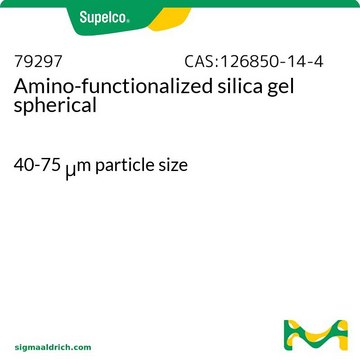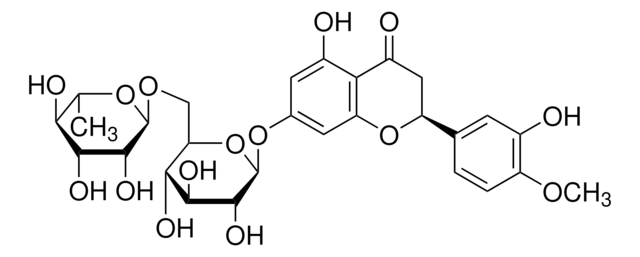569232-U
Discovery® C18 (5 µm) HPLC Columns
L × I.D. 12.5 cm × 4.6 mm, HPLC Column
Synonyme(s) :
Discovery RP18 HPLC Column
About This Item
Produits recommandés
product name
Colonne HPLC Discovery® C18, 5 μm particle size, L × I.D. 12.5 cm × 4.6 mm
Matériaux
stainless steel column
Niveau de qualité
Agence
suitable for USP L1
Gamme de produits
Discovery®
Caractéristiques
endcapped
Fabricant/nom de marque
Discovery®
Conditionnement
1 ea of
Ampleur du marquage
12% Carbon loading
Paramètres
≤70 °C temp. range
400 bar pressure (5801 psi)
Technique(s)
HPLC: suitable
LC/MS: suitable
L × D.I.
12.5 cm × 4.6 mm
Superficie
300 m2/g
Couverture de surface
3 μmol/m2
Impuretés
<10 ppm metals
Matrice
silica gel, high purity, spherical particle platform
fully porous particle
Groupe de la matrice active
C18 (octadecyl) phase
Taille des particules
5 μm
Dimension de pores
180 Å
operating pH range
2-8
Application(s)
food and beverages
Technique de séparation
reversed phase
Vous recherchez des produits similaires ? Visite Guide de comparaison des produits
Catégories apparentées
Description générale
Application
- Rat Pharmacokinetics and In Vitro Metabolite Identification of KM-819, a Parkinson′s Disease Candidate, Using LC-MS/MS and LC-HRMS.: This study underscores the utility of theDiscovery® C18 HPLC Column in pharmacokinetic profiling and metabolite identification of a novel therapeutic agent, demonstrating its critical role in the development of Parkinson′s disease treatments (Choi et al., 2024).
- Determination of 2,4-dimethylhydroxybenzene by chromatographic methods in forensic toxicological research of biological material.: Highlights the application of the Discovery® C18 HPLC Column in forensic toxicology, enhancing the detection and quantification of toxic substances within biological samples, vital for legal and medical investigations (Chernova et al., 2024).
- High-throughput microfluidic chip with silica gel-C18 channels for cyclotide separation.: Illustrates the integration of the Discovery® C18 HPLC Column in a microfluidic setting for efficient and high-throughput separation of cyclotides, offering advancements in peptide and protein analysis (Ebrahimi et al., 2023).
- Priestia megaterium Metabolism: Isolation, Identification of Naringenin Analogues and Genes Elevated Associated with Nanoparticle Intervention.: This research utilizes the Discovery® C18 HPLC Column for the advanced study of microbial metabolism under nanoparticle intervention, pushing the boundaries of biotechnological and pharmaceutical research (Al-Theyab et al., 2023).
- A practical strategy enabling more reliable identification of ginsenosides from Panax quinquefolius flower by dimension-enhanced liquid chromatography/mass spectrometry and quantitative structure-retention relationship-based retention behavior prediction.: Demonstrates the versatility of the Discovery® C18 HPLC Column in complex botanical analyses, particularly in enhancing the reliability of ginsenoside identification, crucial for the development of herbal medicinal products (Sun et al., 2023).
Caractéristiques et avantages
- Reproductibilité excellente
- Forme exceptionnelle des pics des analytes basiques et acides
- Séparations LC-MS stables à faible diffusion
- Séparation des peptides et petites protéines
- Hydrophobicité moindre que celle de nombreuses colonnes comparables, produisant une analyse plus rapide
Informations légales
Colonne de garde
Produit(s) apparenté(s)
Faites votre choix parmi les versions les plus récentes :
Déjà en possession de ce produit ?
Retrouvez la documentation relative aux produits que vous avez récemment achetés dans la Bibliothèque de documents.
Contenu apparenté
Discovery C18 and C8 HPLC Columns products offered
Notre équipe de scientifiques dispose d'une expérience dans tous les secteurs de la recherche, notamment en sciences de la vie, science des matériaux, synthèse chimique, chromatographie, analyse et dans de nombreux autres domaines..
Contacter notre Service technique








